This fresh and healthy tabouli (tabbouleh) recipe is a vibrant Mediterranean salad made with parsley, tomatoes, mint, and bulgur—perfect for a light lunch or heart-healthy side dish.
For more easy mediterranean salads, check out our lentil salad, Mediterranean salad, Greek chickpea salad and rice salad.
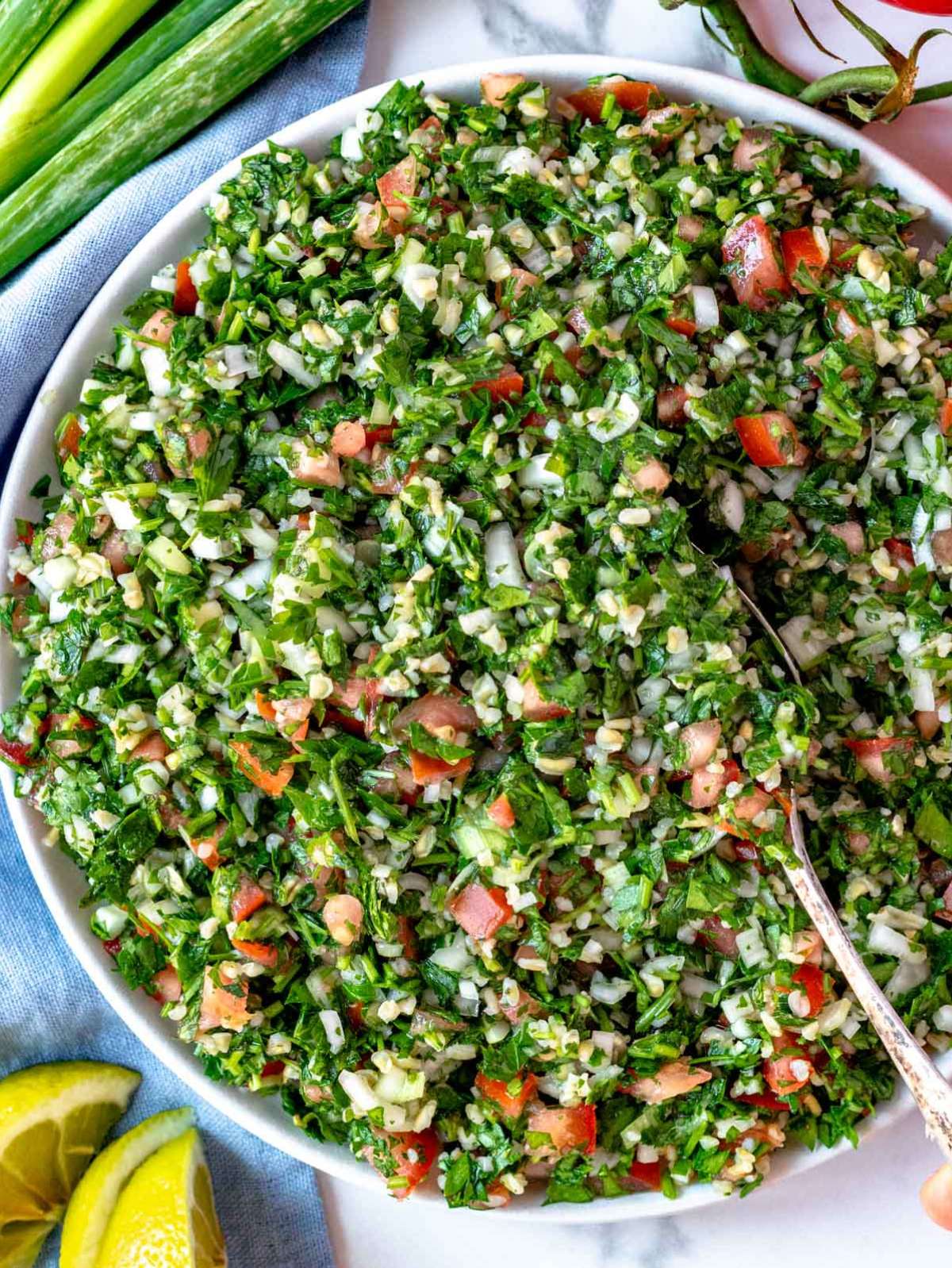
Feel-Good Flavors for a Healthier You
Tabouli (also spelled tabbouleh) is a vibrant, refreshing salad made with finely chopped parsley, mint, tomatoes, scallions, and soaked bulgur wheat, all tossed with extra virgin olive oil and lemon juice 🍋.
This classic Middle Eastern dish isn’t just delicious—it’s also incredibly good for you. At home, Louise and I love it as one of our go-to low calorie salad recipes that’s fiber-rich, heart-healthy, and naturally plant-based.
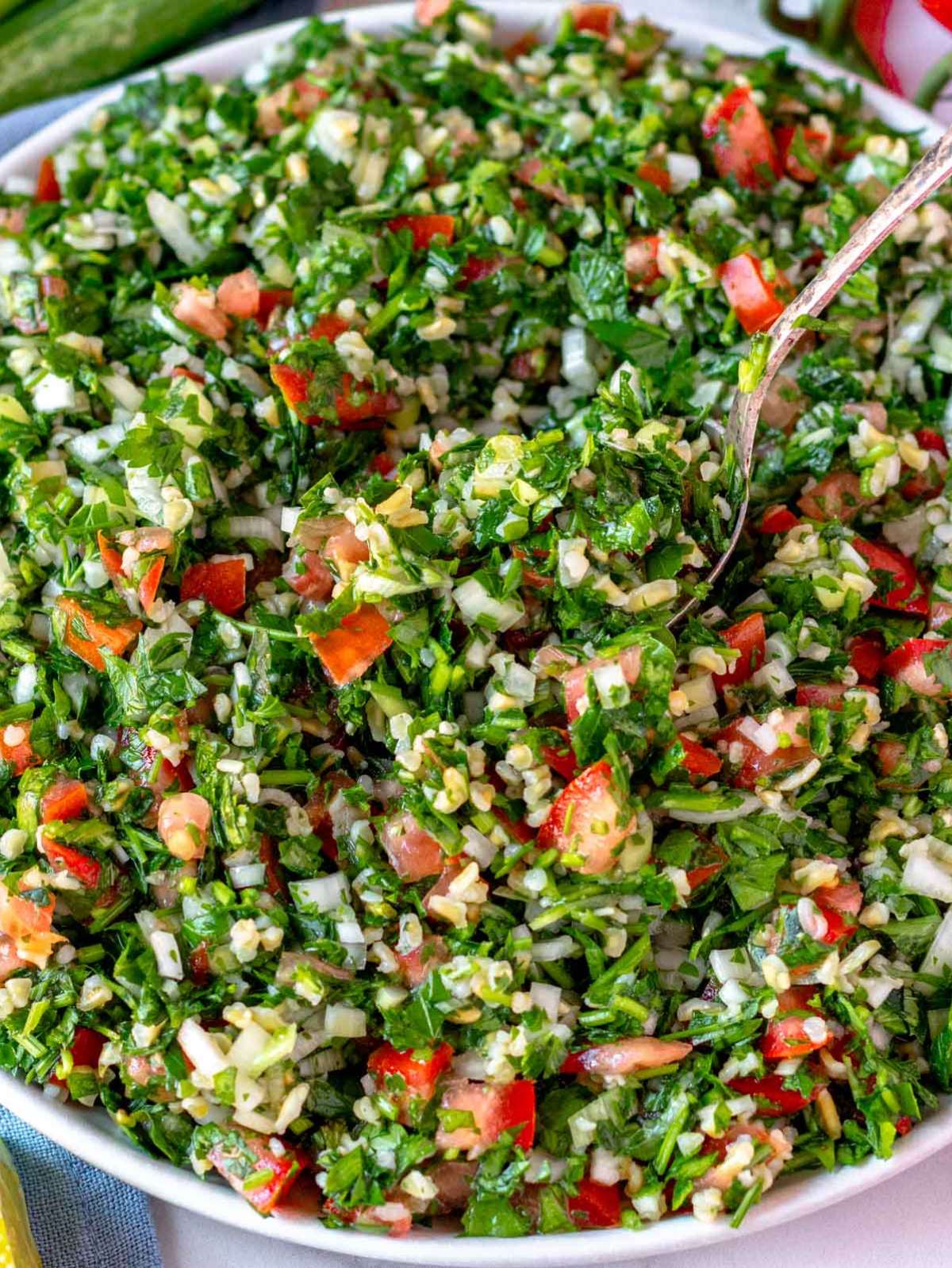
Parsley and mint bring antioxidants and anti-inflammatory benefits, while bulgur provides complex carbs and a satisfying chew. It’s the kind of dish that leaves you feeling energized—not weighed down.
Whether you’re prepping a cold salad for a potluck, packing lunch for work, or making vegetarian sides for grilling season, this tabouli recipe checks all the boxes ✅.
It’s light, zesty, and bursting with fresh flavor, and it gets even better after a little time in the fridge. Best of all, you can customize it with gluten-free grains, legumes, or even serve it lettuce-wrap style for a fun summer snack 🥬. Simple, wholesome, and full of Mediterranean flavor—this tabouli is everything we love in a salad.
Ingredients
Full ingredients and substitutions are in the recipe box below.
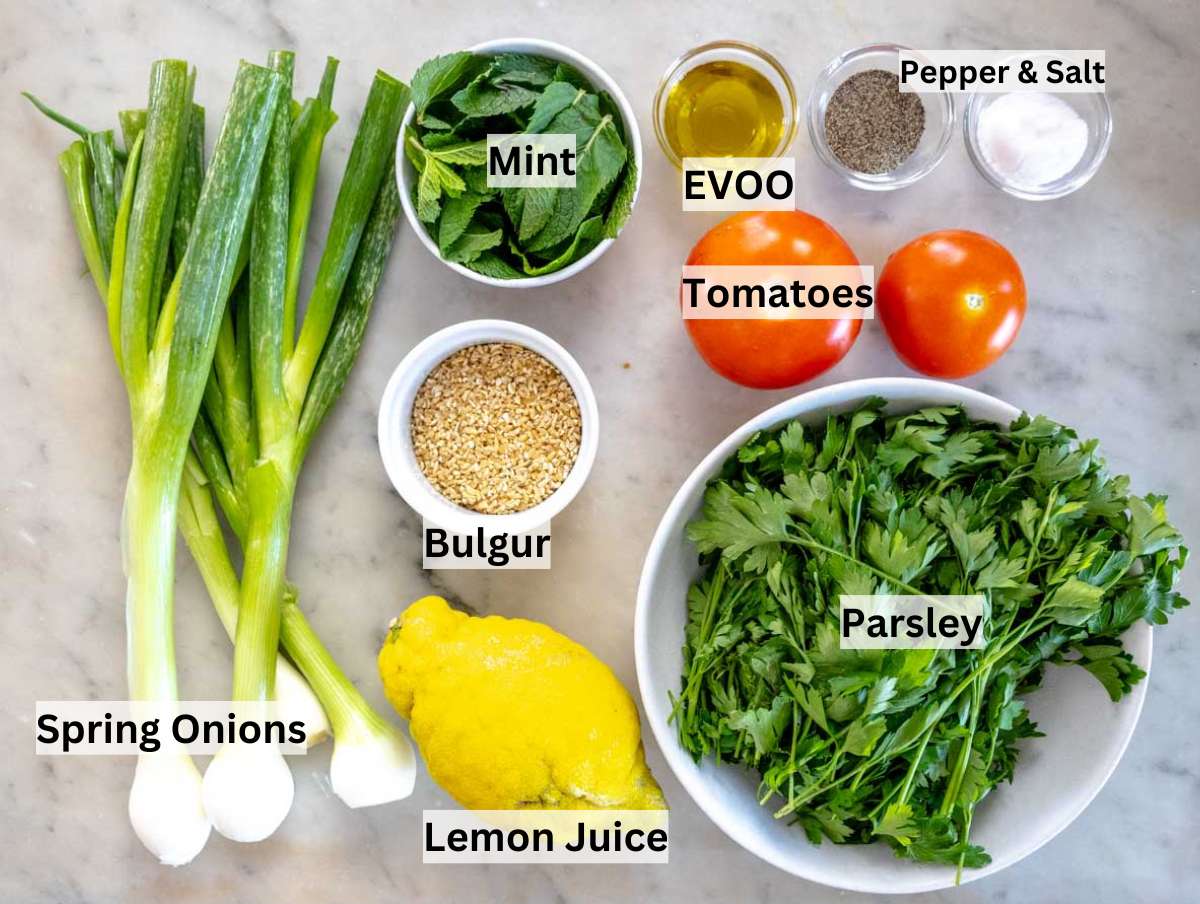
- Fresh Parsley: Flat-leaf or Italian parsley is the main ingredient in tabouli salad. Substitute with curly parsley in a pinch, but flat-leaf gives better texture and flavor. Remove thick stems and chop finely with a sharp knife for the best tabouli salad texture.
- Mint: Fresh mint adds a refreshing lift. Substitute with basil or cilantro if you don’t have mint, though these change the flavor profile.
- Tomatoes: Use ripe, juicy tomatoes like Roma, beefsteak, or vine. If tomatoes are out of season, substitute with pomegranate seeds or cherry tomatoes for a sweet twist.
- Scallions or Green Onions: These add mild onion flavor. Substitute with finely chopped white or red onion if needed.
- Bulgur: Traditional tabbouleh uses fine bulgur soaked in water. For a gluten free tabouli, use quinoa, cauliflower rice, or millet. You can also try couscous or buckwheat for a fun twist.
- Lemon Juice: Freshly squeezed lemon juice gives brightness and acidity. You can use lime juice in a pinch, but the flavor will be slightly different.
- Olive Oil: Extra virgin olive oil adds richness and ties all the flavors together. You can substitute with avocado oil for a milder flavor.
- Salt and Pepper: Sea salt and freshly ground black pepper bring balance. Use kosher salt or Himalayan salt if preferred.
- Lettuce (optional): Romaine lettuce is sometimes chopped and mixed in, or used whole as a serving vessel. Substitute with butter lettuce or endive leaves for presentation.
- Add-ins (optional): For a twist on this healthy summer salad, try chopped cucumber, cherry tomatoes, garlic, olives, or crumbled feta. For more fiber or protein, add lentils, quinoa, or even a spoon of hummus on the side.
Variations
- Quinoa Tabbouleh: Substitute boiled quinoa for bulgur to make a gluten-free version. Quinoa adds a light, nutty flavor and extra protein, perfect for a healthy summer salad or meal prep.
- Lentil Tabbouleh: Swap bulgur with cooked brown, green, or black lentils for a heartier texture and a boost of fiber and iron. This variation works well as a cold salad for potluck gatherings or packed lunches.
- Chickpea Tabbouleh: Replace bulgur with canned or cooked chickpeas for a protein-rich twist. Chickpeas give the tabbouleh a creamy bite and make it a satisfying plant-based main dish.
How to Make Tabouli
Step 1: Prepare the Bulgur
Start by cooking the bulgur wheat. You can either boil it according to the package directions, then drain and let it cool for 10 minutes.
Or, for a more traditional tabbouleh texture, soak the bulgur in hot water for about 20 minutes until it softens. Once soaked, squeeze out any extra water using your hands and transfer it to a large mixing bowl.
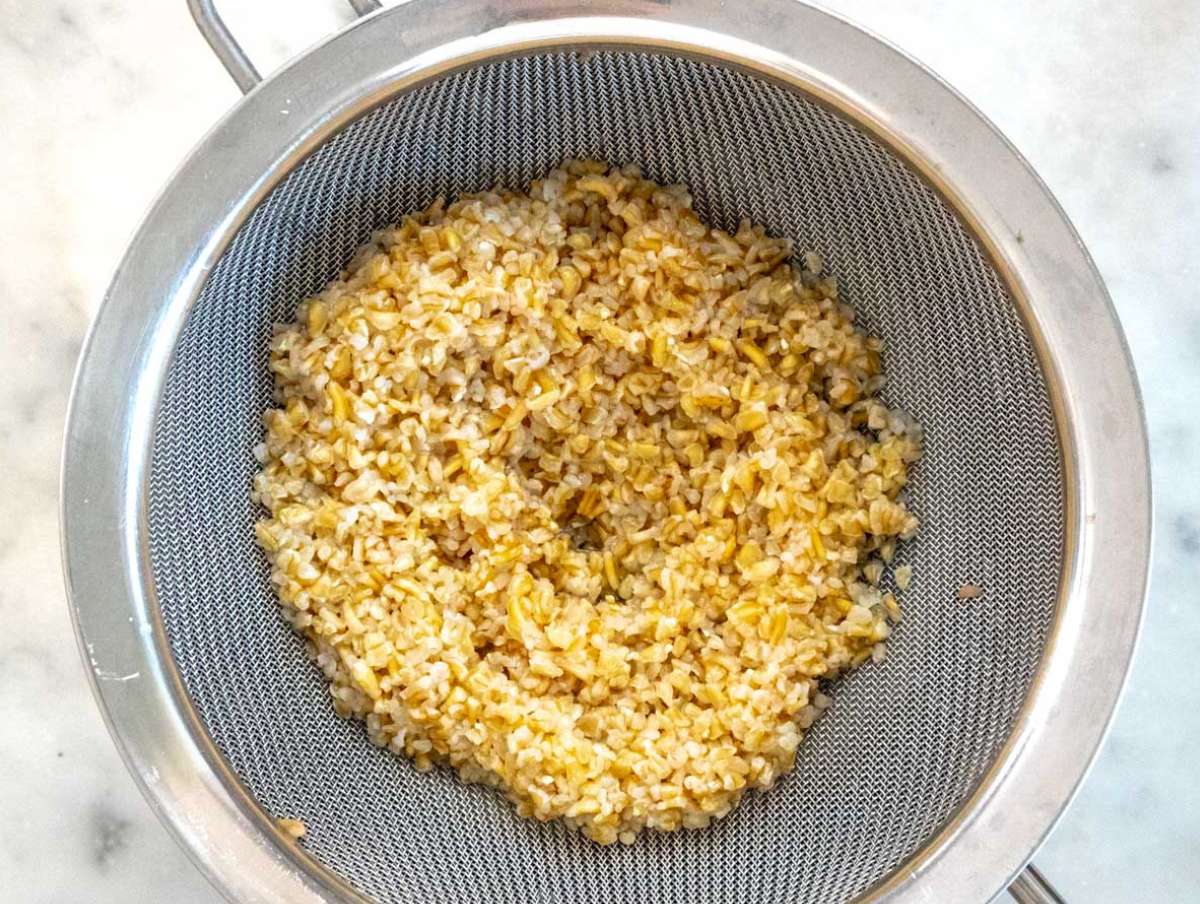
Step 2: Chop the Vegetables
Finely chop the tomatoes into small pieces and add them to the bowl with the bulgur. If the tomatoes are very juicy, let them drain in a mesh strainer for a few minutes first.
Rinse and dry the parsley and mint. Remove the thick stems, then chop the leaves finely with a sharp knife. Add them to the bowl.
Slice the scallions (green onions), using only the white and light green parts, and toss them in with the rest.
Tip: Take your time with the chopping—it makes a big difference in the final texture of this fresh, herb-packed salad.
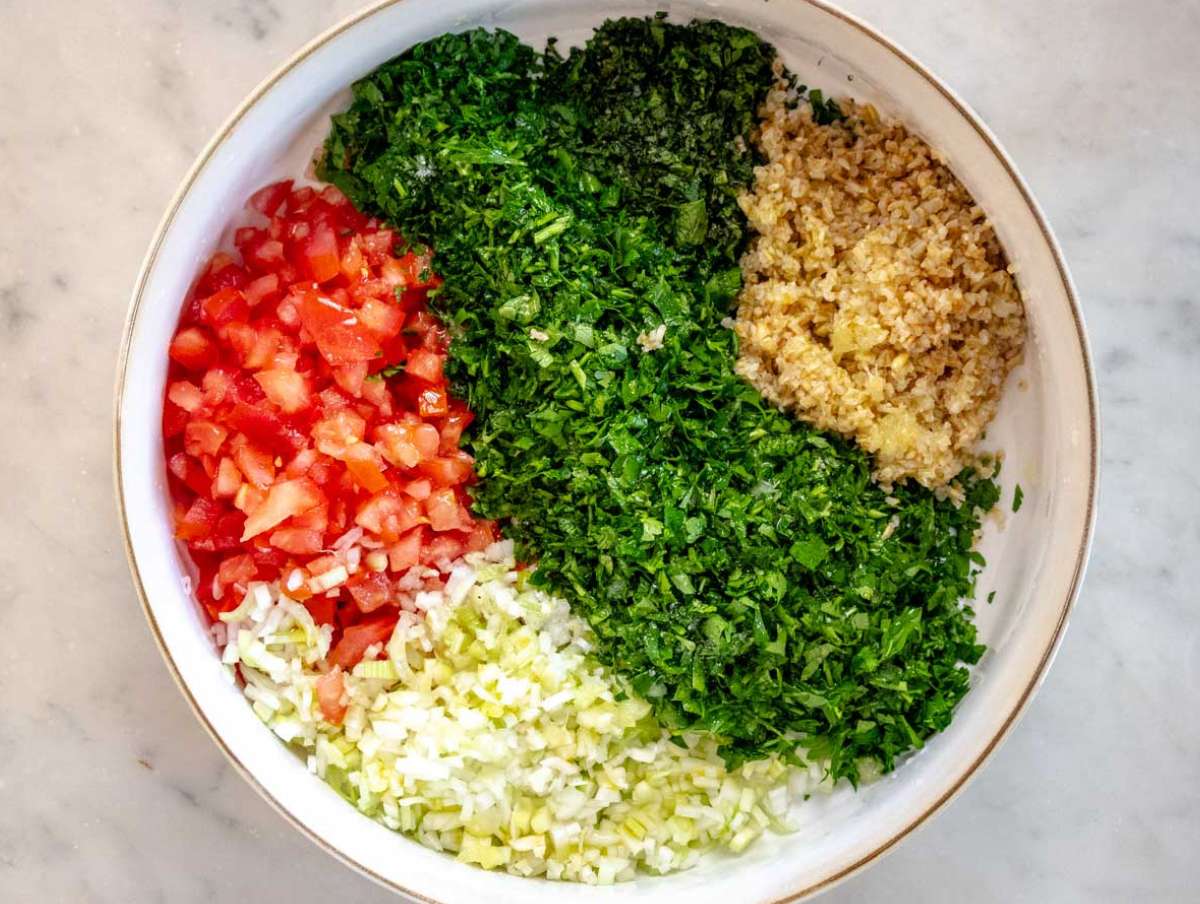
Step 3: Season the Salad
Drizzle in extra virgin olive oil and freshly squeezed lemon juice. Season with sea salt and black pepper.
Mix everything well with a spoon or your hands. Taste and adjust the lemon or salt if needed. You can serve it right away, but it tastes even better after chilling in the fridge for 30 minutes.
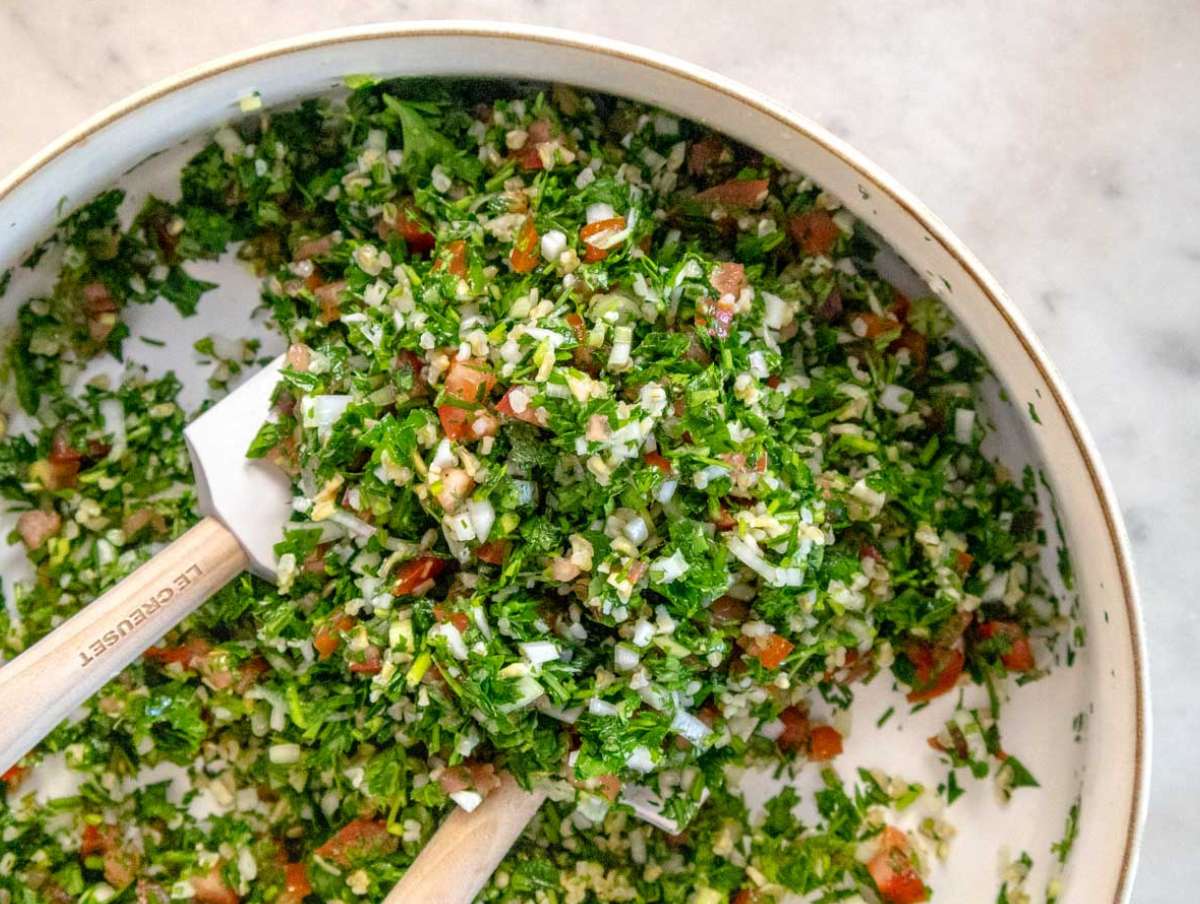
Step 4: Serve and Enjoy
Serve your tabbouleh as a cold salad, side dish, or light lunch. It’s one of our favorite plant-based side dishes for warm weather!
Pair it with other Mediterranean favorites like hummus, baba ganoush, grilled eggplant, or falafel. You can also scoop it into lettuce leaves or pita bread for easy serving at BBQs, picnics, or potlucks.
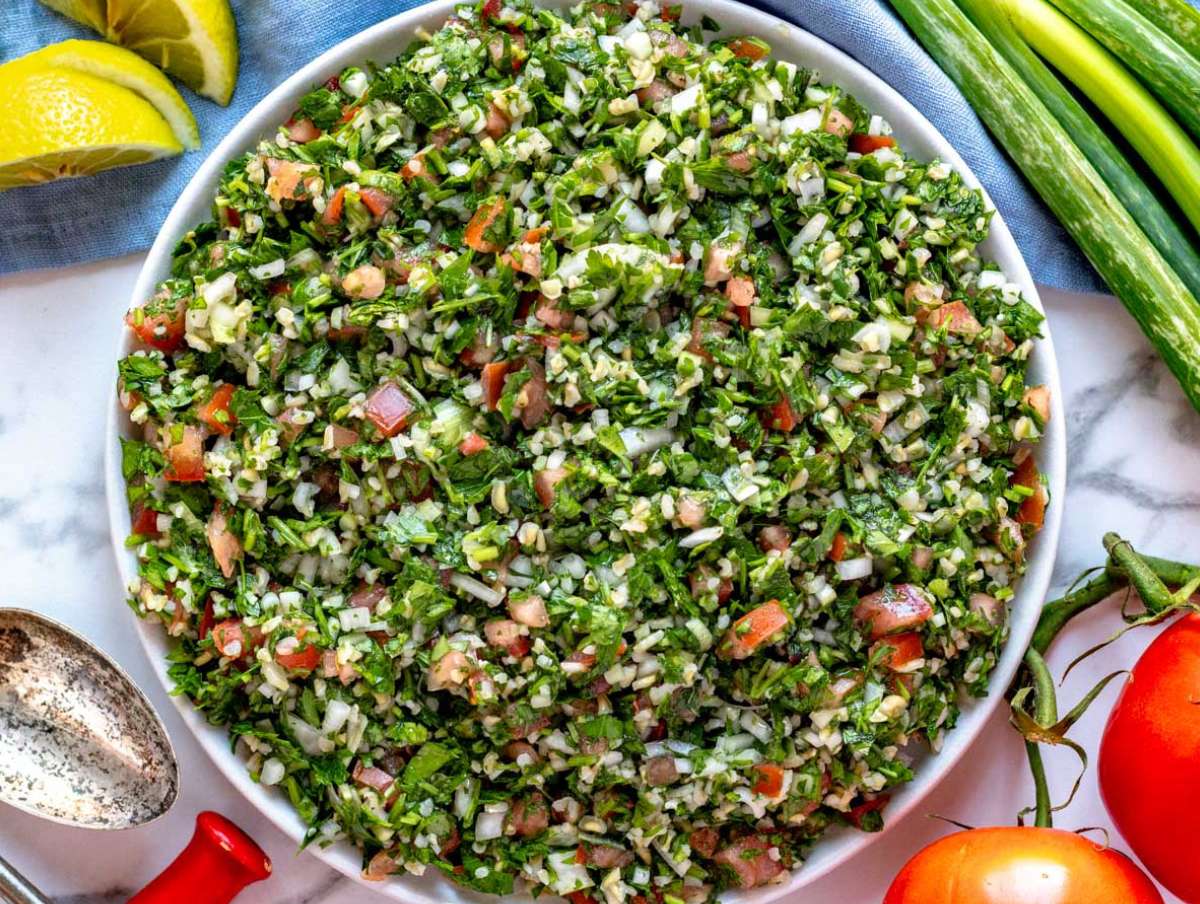
Tips
- Chop by hand, slowly and mindfully: In traditional Lebanese homes, parsley is often chopped by hand with a sharp knife—not because it’s faster, but because it’s gentler. This preserves the vibrant green color and prevents bruising the herbs.
- Use fine bulgur (#1 grind): Many recipes don’t specify the grind, but fine bulgur is key to achieving that light, fluffy texture. Coarser bulgur (#2 or #3) is better suited for cooked pilafs, not tabbouleh.
- Balance the green-to-grain ratio: True tabbouleh is mostly green—parsley should dominate, not the bulgur. A rough guide is 3 to 4 parts parsley to 1 part bulgur, which flips the script on how many Americanized versions are made.
- Salt the tomatoes early: After chopping, toss the tomatoes with a bit of salt and let them sit while you chop the herbs. This draws out excess moisture and intensifies their flavor before mixing.
- Use your hands to mix: Like many Levantine salads, tabbouleh is often mixed gently by hand to avoid crushing the herbs and to distribute the seasoning evenly.
- Don’t skip the resting time: Tabouli tastes best after sitting for at least 30 minutes. This allows the bulgur to soak up the lemon and tomato juices, making every bite flavorful.
Frequently Asked Questions
Use fine bulgur (also labeled #1 grind) for traditional tabbouleh. It soaks quickly, blends well with the chopped herbs, and has a delicate texture. Coarser bulgur is better for hot pilafs or grain bowls. If you can’t find #1 grind, coarser bulgur will be just fine.
Yes! For a gluten free tabouli, substitute cooked quinoa, cauliflower rice, or millet for the bulgur. Quinoa is the most popular swap—it’s light, fluffy, and rich in protein.
Absolutely. In fact, tabbouleh tastes even better after resting in the fridge for a few hours. The flavors meld and the bulgur absorbs the lemon juice and tomato juices, making it even more delicious.
Yes, tabouli is one of the best low calorie salad recipes you can make. It’s packed with fiber, antioxidants, and anti-inflammatory ingredients like parsley, mint, lemon, and olive oil. Plus, it’s naturally vegan and dairy-free.
Watery tabouli usually happens when the tomatoes are too juicy or the parsley wasn’t dried properly. Try salting and draining the tomatoes first, and pat the herbs dry with a kitchen towel before chopping.
Yes, but pulse carefully. A food processor can make the parsley mushy if over-processed. For best results, use a sharp knife and chop by hand for a bright, fluffy texture.
Not necessarily. Fine bulgur can be soaked in hot water and left to absorb moisture. This is the more authentic method and gives tabbouleh a light, chewy texture.
More Easy Mediterranean Recipes
- Spanakopita (Greek spinach pie)
- Greek zucchini patties
- Summer pasta salad
- Stuffed tomatoes with rice
- Quinoa lentil salad
- Italian potato salad
- Vegetarian stuffed peppers
- Greek pasta salad
If you tried this tabouli recipe or any other recipe on our blog, please leave a 🌟 star rating and let us know how it goes in the comments. We love hearing from you!
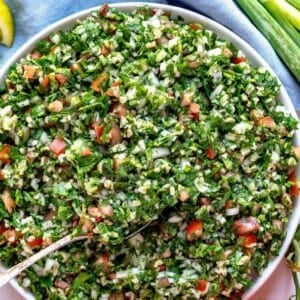
Tabouli (Tabbouleh)
Video
Ingredients
- ¼ cup bulgur
- 3 packed cups flat-leaf parsley finely chopped
- ¼ cup mint leaves finely chopped
- 5 spring onions finely chopped
- ½ pound tomatoes cut into small dice
- 2 tablespoons extra virgin olive oil
- 2 tablespoons lemon juice
- 1 teaspoon salt or more to taste
- ⅛ teaspoon black pepper
Instructions
- Prepare the Bulgur: Soak ¼ cup bulgur in hot water for 20 minutes, then squeeze out excess water and add to a large bowl. Or boil it per package instructions and let cool.
- Chop the Vegetables: Finely chop 3 packed cups flat-leaf parsley, ¼ cup mint leaves, 5 spring onions, and ½ pound tomatoes. Drain tomatoes if too watery. Add all to the bowl with the bulgur.
- Season the Salad: Add 2 tablespoons extra virgin olive oil, 2 tablespoons lemon juice, 1 teaspoon salt, and ⅛ teaspoon black pepper. Mix well, taste, and adjust seasoning. Chill for 30 minutes if possible.
- Serve and Enjoy: Serve cold as a light lunch or healthy side with pita, hummus, or grilled veggies. Great for BBQs and potlucks!
Notes
- Parsley: Flat-leaf is best for texture. Curly works in a pinch—chop finely!
- Mint: Adds freshness. Swap with basil or cilantro if needed.
- Tomatoes: Use ripe ones. Try cherry tomatoes or pomegranate seeds as subs.
- Scallions: Mild and tangy. Use red or white onion if that’s what you have.
- Bulgur: Use fine bulgur or swap with quinoa, millet, or cauliflower rice for gluten-free.
- Lemon Juice: Fresh is best. Lime works in a pinch.
- Olive Oil: Use extra virgin. Avocado oil is a milder option.
- Salt & Pepper: Sea salt and black pepper balance the flavor—adjust to taste.
- Lettuce (optional): Serve in romaine or butter lettuce cups for a fun twist.
- Add-ins: Try cucumber, garlic, olives, feta, lentils, or hummus for variety.
- Chop herbs by hand: It keeps the parsley bright and prevents bruising.
- Use fine bulgur (#1): For light, fluffy texture—skip the coarse stuff.
- Parsley > Bulgur: Aim for 3–4 parts parsley to 1 part bulgur for authentic flavor.
- Salt tomatoes early: Helps remove excess water and boosts flavor.
- Mix by hand: Gently blends everything without crushing the herbs.
- Let it rest: Chill for 30+ minutes so flavors can fully develop.
Nutrition

Hi! We are Nico & Louise
We’re here to share delicious, easy, and healthy plant-based recipes (vegetarian & vegan) 🌿✨.
Welcome to our blog, we are glad you are here.





I love all your recipes; the videos are especially helpful as well as the suggestions and substitutions
Thank you a
Thanks, Sara! So happy the videos help, we have a lot of fun filming those.
I like a slightly higher ratio of bulgar to vegetables and herbs than is traditional for this style of Tabouleh* so I doubled the amount to a half cup and soaked it in slightly less than a cup of boiling water. There was very little excess liquid to drain off. In addition to somewhat more than a half pound of finely diced heirloom tomato (I used a combo of yellow and red for extra colour) I added two finely diced baby seedless cucumbers, plus hand-chopped flat leaf parsley (probably barely half the amount called for as that was all I had on hand), scallions and mint and dressed with the fresh squeezed lemon and extra virgin olive oil seasoned with salt and pepper. Lovely and fresh-tasting. Will definitely make again, trying a bit of crushed garlic and feta in the mix.
* The Syrian version of bulgar salad, Bazargan (which means of the bazaar) is very different, primarily bulgar, with only a small amount of minced parsley and dressed with olive oil, tamarind paste or pomegranate molasses, a bit of tomato paste, lemon juice, ground cumin, coriander and allspice, a pinch of ground cayenne, chopped walnuts and pine nuts.
I made this with Buckwheat since I’m gluten free. So good! Even better when I topped it with hummus.
I’m glad to see a recipe for tabbouleh salad that has the right ratio of parsley to bulgur. Most times it has way to much bulgur for the salad. Tabbouleh is about showcasing the parsley. A traditional short cut is to use fine grade bulgur and soak it in the lemon juice. This way you don’t have to bother with draining and squeezing the water out of the bulgur. You might need a little more lemon juice though.
Simply delicious